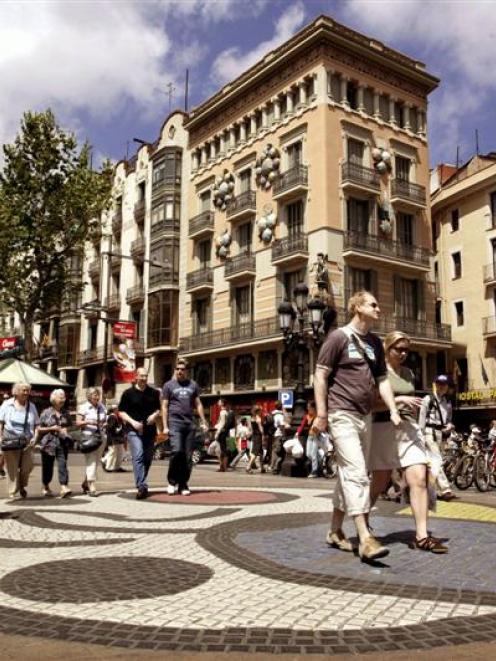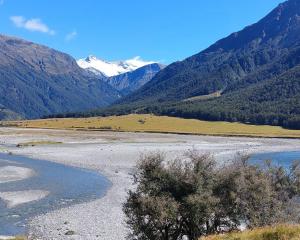
Barcelona - with its rich history, Roman ruins, Gothic cathedrals, Art Nouveau-inspired apartment buildings and hyper-modern hotels - invites the closer look that you can get only on foot.
In fact, several of Barcelona's most popular neighbourhoods are for pedestrians only. Cars often are off-limits or only grudgingly accommodated.
My favourite memories of other cities - Paris, of course, and New York - are of the hours I spent on foot, stopping in front of every store window that caught my attention, following the winding streets to see where they led.
So when I visited Barcelona for the first time, I decided to walk my way through it.
The Barcelona Office of Tourism offers four guided walking tours that start at the Placa de Catalunya, the large city square at the top of La Rambla, one of the most popular walking streets.
I signed up for a tour (with an English-speaking guide) of the Barri Gotic, the Gothic quarter that still has the flavour of its medieval roots.
Some of the quarter's streets are named for the guilds that once flourished here, including bookbinders, swordmakers and others.
But before I took the tour, I spent two days taking in La Rambla on my own.
The street comes to life around noon, and by 7pm, it's crowded with locals stopping on their way home to meet friends or do errands. (Cars are limited to narrow lanes on each side of the pedestrian mall.)As I wandered down La Rambla, with its magazine stands, flower stalls and birdcages filled with parakeets and canaries, I passed tapas bars serving eggplant frittata, salted almonds, shrimp in olive oil and potato salad.
Pastry shop Escriba Patisseries is a haven for chocolate lovers.
You almost can't miss the restaurant, at 83 La Rambla, housed in a Modernisme-style building, akin to French Art Nouveau architecture, and decorated with a green-and-violet floral pattern on the facade.
Halfway down La Rambla, heading from Placa de Catalunya towards the seaport, is one of the most popular meeting places in the neighbourhood, Mercat de la Boqueria, the local market.
The food hall is filled with restaurants, fresh produce, fish, meat and other products, including almonds, figs, olives and ground spices.
One stand specialises in organ meats, and the day I was there, I got a full view of a sheep's head and a cow's stomach, digestive tubes still attached, displayed among the tripe, pigs' feet, sweetbreads and brains.
At Pinotxo, one of the busiest of the market's restaurants, people stood three deep behind each of six or so stools and a counter, waiting their turn.
La Rambla is also the city's unofficial performance space. Mimes and living sculptures add to the street-fair atmosphere.
But for me, the narrow side streets that went from La Rambla into Barri Gotic were far more appealing. So I signed up for a $23 walking tour of the neighbourhood.
At 10.30am, I joined two tourists from Australia and three from England. Our guide, a Barcelona native who was fluent in English and the history of her city, gave us a generous two-hour tour.
Our group set out from the Placa de Catalunya on to Avenida de la Portal de l'Angel, where tapas bars were tucked between clothing boutiques.
Wearing the wide tile facade of a doctor's clinic, a shop called Happy Pills showcased spicy jellybeans in bins. Purchases were packed in medicine bottles.
We passed the remains of a Roman wall dating from the fourth century and on to the Gothic-style Holy Cross Cathedral, started in the 14th century and completed in the 19th.
Palm trees rustle and geese roam in its interior courtyard. Its tall, narrow spires recall the taller, narrower spires of the Sagrada Familia, a half-hour walk away.
The church by architect Antonio Gaudi - an icon of Modernisme architecture - is still under construction, although Gaudi died in 1926.
Among the most stylish new buildings is Neri Hotel, which has a dark glass facade.
It is hidden deep in the Barri Gotic quarter, at St Philip Neri Square, named for the church that dominates the small cobblestoned space.
Coming upon it, our guide pointed out places on the church exterior where the stone had been blown away by a bomb during the Spanish Civil War in the 1930s. Many children from the neighbouring school were killed by the blast.
On the nearby Carrer de Marlet, the remains of a medieval Jewish synagogue recall another dark era in the city's history. The small, one-room structure is at the centre of the Jewish Quarter.
Jews were driven out of Spain during the Inquisition that began in the 15th century, after Christianity was made the country's official religion.
The centuries of historic landmarks in the Barri Gotic are updated by modern shops selling handmade chocolates, leather goods and other artful products made in Catalonia.
On my next visit, I want to take the Modernist Walking Tour, for a closer look at the architecture of Gaudi, Josep Puig i Cadafalch and others who helped make Barcelona a showplace of Modernisme.
After that, there is the Picasso Walking Tour and then the Gourmet Tour. The city is worth at least that many return trips.
If you go
Where to eat
- Els Quatre Gats, 3 bis Carrer de Montsio; www.4gats.com/web.html. A local café that was once a favourite of artists Pablo Picasso, Miguel Utrillo and others. A blend of colourful tiles and natural wood, plus an outdoor patio give the room a cosy feeling. Meals from about $48.
- Bar Pinotxo, Mercat de la Boqueria. Breakfast, lunch or afternoon snacks. This tiny bar inside the Mercat de la Boqueria market is casual and lively, serving tapas made from the fresh produce sold in the nearby stalls. Meals about $20.
To learn more
- Tourist Office of Spain, (323) 658-7188, www.spain.info












